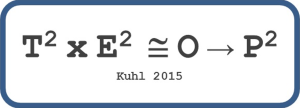 About one hundred and seventy-seven million. That’s the number of hits you’ll find if you go to Google and search for the phrase “work-life balance.” Apparently, there’s a lot to be said on the topic. What’s the optimal balance between work and real life? What does it mean to be a “high performer” in the context of being a fulfilled person, not just a productive employee?
About one hundred and seventy-seven million. That’s the number of hits you’ll find if you go to Google and search for the phrase “work-life balance.” Apparently, there’s a lot to be said on the topic. What’s the optimal balance between work and real life? What does it mean to be a “high performer” in the context of being a fulfilled person, not just a productive employee?
The original Performance Equation intentionally addresses performance as it relates to success in specific job roles. You  probably know all too well that satisfaction with and in your career affects your sense of well-being in other aspects of life. Being stuck in a job opportunity that is not a natural fit to your talents, energies, attitudes, and beliefs can create chronic crankiness at a minimum, and for some in severe situations, lead to deep depression.
probably know all too well that satisfaction with and in your career affects your sense of well-being in other aspects of life. Being stuck in a job opportunity that is not a natural fit to your talents, energies, attitudes, and beliefs can create chronic crankiness at a minimum, and for some in severe situations, lead to deep depression.
However, even for workaholics, life has more to offer than just career satisfaction—factors that can far outweigh the ills of a crappy job.
Dr. Martin E. P. Seligman is a psychologist, best-selling author, and one of the founding thinkers behind the relatively new discipline of Positive Psychology. As he explains in his book, Flourish (2011), humans have tended to think about the pursuit of happiness as the path to a good life. But modern-day, first-world thinkers view happiness is a transitory state, a mood often equated with superficial cheerfulness, merriment, and smiles.
Through his years of research, Dr. Seligman has developed a richer, more complex model for thinking about what constitutes a good life. He calls this the Theory of Well-Being. People enjoying a state of well-being are doing much more than just surviving. Well-being encompasses a sense of satisfaction with your life and the belief that you are functioning well—that is, you are growing, learning, and making a positive difference in your world. This brings us, finally, the second of the titular Two Models that I promised you:
Model #2: The Elements of Well-Being
Well-being theory posits a robust model made up of five key factors that, taken together, create a life of fulfillment, meaning, and satisfaction. Each of the five elements uniquely contributes to an individual’s sense of well-being—none alone is sufficient to achieving well-being. And as with the Performance Equation, if any factor is absent, well-being cannot be fully achieved; conversely, when all are present at optimal levels, the overall result is larger. Therefore, I have taken the liberty (without Dr. Seligman’s knowledge or permission) of presenting the Theory of Well-Being as a multiplication equation:
P is for Positive Emotion. Positive emotions are fleeting responses to changes in the way individuals interpret their current circumstances. When you register that a situation is in some way bad for you, a negative emotion arises; when you sense good fortune, enjoyment, or opportunity, a positive emotion arises. The functions of emotions, both positive and negative, were shaped over millennia by the processes of natural selection to increase an individual’s resources for survival.
Dr. Barbara L. Fredrickson has been researching positive emotion for more than 25 years, and is considered a leading scholar in social psychology, affective science, and positive psychology. The list of possible positive emotions is a long one, but in a recent publication (2013), Fredrickson focused on the following 10 positive emotions because they are well-researched and also because they are things we all tend to experience fairly often in our daily lives: joy, gratitude, contentment, interest, hope, pride, amusement, inspiration, awe, and love. Indeed, life would be bleak without these.
Next in the formula is E. In this context, E represents Engagement—that sense of being totally absorbed in what you are doing, to the degree that you lose all sense of time, and everything melts away except for your intense focus on the activity at hand. In explaining this factor, Seligman draws heavily on the research and writings of Mihaly Csikszentmihalyi. In the business world, Csikszentmihalyi is perhaps best known for his books in the popular press, including Flow: the Psychology of Optimal Experience (1990) and Finding Flow: the Psychology of Engagement with Everyday Life (1997). (Psychology Today magazine offers a nice summary of flow in its online review of Finding Flow.) Individuals can enjoy the enriching benefits of engagement in their vocations, avocations, or ideally, in both.
R stands for Relationships. John Donne wasn’t kidding when he said, “No man is an island.” Life on planet Earth inevitably involves interacting with other humans. Put succinctly, this factor reflects the capacity to love and to be loved, and honors the essential role that forming and nurturing positive relationships with others plays in achieving well-being.
M equals Meaning. Seligman believes that the “…Meaningful Life consists in belonging to and serving something that you believe is bigger than the self” (2011). Literature from many cultures is littered with archetypal characters who have every material possession and every sensual pleasure imaginable, and yet feel hollow and unfulfilled. The solution? Devoting one’s life to the pursuit of meaningful goals, to making the world a better place, even simply helping another person.
A is for Acomplishment. This final factor acknowledges that people are, to varying degrees, hard-wired grow and take action for their benefit in whatever environment they happen to find themselves. We want to accomplish something, although that something differs from person to person, and for any individual, typically changes over time.
So there you have it, as promised:
- One goal: to bring together recent research from the fields of neuroscience, psychology, psychometrics, and predictive analytics and use that research to create a coherent approach to increasing performance and well-being in one’s career and life—what I refer to as achieving exponential performance
- Two models:
- The Performance Equation
- The Theory of Well-Being
- Eight factors:
- Talent
- Effort
- Opportunity
- Positive emotion
- Engagement
- Relationships
- Meaning
- Accomplishment
 Well, that’s all fine and lovely, but eagle-eyed readers may see a problem here. The equation for Exponential Performance is notably missing any reference to WB. How do the Performance Equation and the Theory of Well-Being mesh into one coherent model?
Well, that’s all fine and lovely, but eagle-eyed readers may see a problem here. The equation for Exponential Performance is notably missing any reference to WB. How do the Performance Equation and the Theory of Well-Being mesh into one coherent model?
Patience, Grasshopper! Now that we’ve got both models laid out, it’s time to revisit Opportunity and enrich our thinking on that component of the equation.
~~~
